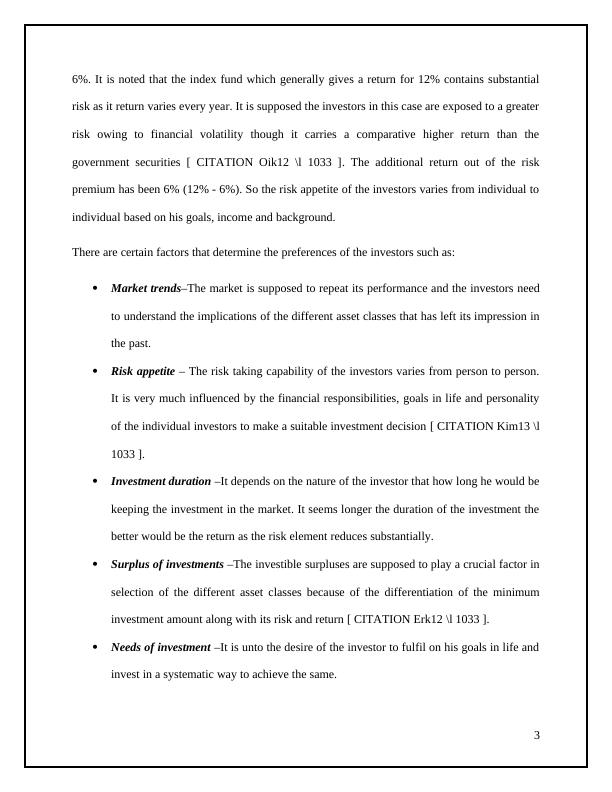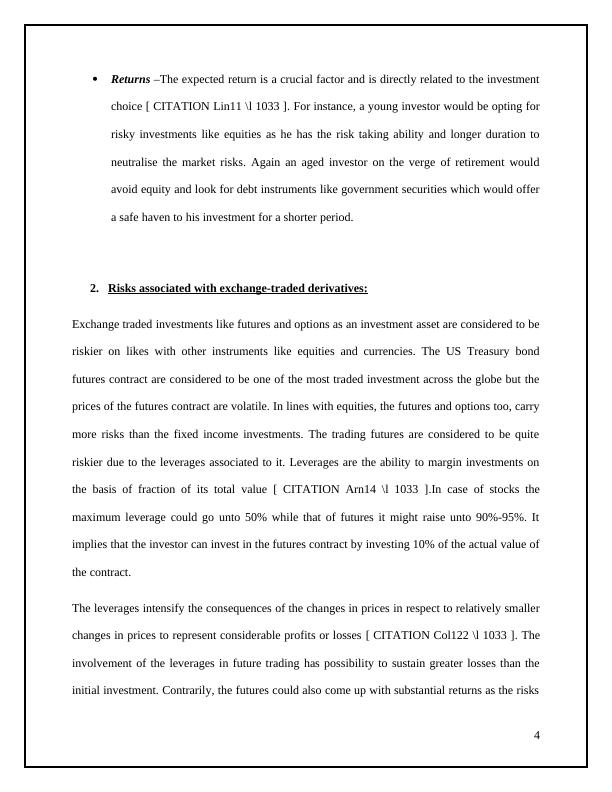Attraction Towards High Risk Investment
11 Pages2666 Words100 Views
Added on 2020-02-24
Attraction Towards High Risk Investment
Added on 2020-02-24
ShareRelated Documents
HIGH-RISK INVESTMENT1

1.Investors’ attraction towards high risk investment:Risks stand for the chance that the actual return of the investment would differ from theanticipated return. It is the possibility of losing the potential investment and in certain cases losesthe capital as well [ CITATION Dor12 \l 1033 ]. Higher returns are related with higher risks andvice versa. So the risk/return trade-off would strike for a balance between the desires for thelowest possible risk and the highest plausible return. The scenario has been depicted below bythe risk/return trade-off presented in the figure below showing a higher standard deviationindicates for a higher risk along with higher plausible return. Figure 1: Relation between risk and returnSource: [ CITATION Jac13 \l 1033 ]It is a misconception that higher risk would yield higher returns. According to the risk/returntrade-off higher risk has bearings with the possibility of higher returns but there is no suchguarantee. This is because higher potential returns would implicate higher potential losses[ CITATION Jac13 \l 1033 ]. The risk-free rate of return is depicted by the US GovernmentSecurities as the instrument stands little chance of default. If the government securities offer areturn of 6%, it indicates that there are no such risks and the instrument could yield a return of2

6%. It is noted that the index fund which generally gives a return for 12% contains substantialrisk as it return varies every year. It is supposed the investors in this case are exposed to a greaterrisk owing to financial volatility though it carries a comparative higher return than thegovernment securities [ CITATION Oik12 \l 1033 ]. The additional return out of the riskpremium has been 6% (12% - 6%). So the risk appetite of the investors varies from individual toindividual based on his goals, income and background. There are certain factors that determine the preferences of the investors such as:Market trends–The market is supposed to repeat its performance and the investors needto understand the implications of the different asset classes that has left its impression inthe past. Risk appetite – The risk taking capability of the investors varies from person to person.It is very much influenced by the financial responsibilities, goals in life and personalityof the individual investors to make a suitable investment decision [ CITATION Kim13 \l1033 ]. Investment duration –It depends on the nature of the investor that how long he would bekeeping the investment in the market. It seems longer the duration of the investment thebetter would be the return as the risk element reduces substantially. Surplus of investments –The investible surpluses are supposed to play a crucial factor inselection of the different asset classes because of the differentiation of the minimuminvestment amount along with its risk and return [ CITATION Erk12 \l 1033 ]. Needs of investment –It is unto the desire of the investor to fulfil on his goals in life andinvest in a systematic way to achieve the same. 3

Returns –The expected return is a crucial factor and is directly related to the investmentchoice [ CITATION Lin11 \l 1033 ]. For instance, a young investor would be opting forrisky investments like equities as he has the risk taking ability and longer duration toneutralise the market risks. Again an aged investor on the verge of retirement wouldavoid equity and look for debt instruments like government securities which would offera safe haven to his investment for a shorter period. 2.Risks associated with exchange-traded derivatives:Exchange traded investments like futures and options as an investment asset are considered to beriskier on likes with other instruments like equities and currencies. The US Treasury bondfutures contract are considered to be one of the most traded investment across the globe but theprices of the futures contract are volatile. In lines with equities, the futures and options too, carrymore risks than the fixed income investments. The trading futures are considered to be quiteriskier due to the leverages associated to it. Leverages are the ability to margin investments onthe basis of fraction of its total value [ CITATION Arn14 \l 1033 ].In case of stocks themaximum leverage could go unto 50% while that of futures it might raise unto 90%-95%. Itimplies that the investor can invest in the futures contract by investing 10% of the actual value ofthe contract.The leverages intensify the consequences of the changes in prices in respect to relatively smallerchanges in prices to represent considerable profits or losses [ CITATION Col122 \l 1033 ]. Theinvolvement of the leverages in future trading has possibility to sustain greater losses than theinitial investment. Contrarily, the futures could also come up with substantial returns as the risks4

End of preview
Want to access all the pages? Upload your documents or become a member.
Related Documents
The Concept of Profit Maximisationlg...
|11
|1242
|66
Risk and Return Concepts in Financial Managementlg...
|4
|547
|235
